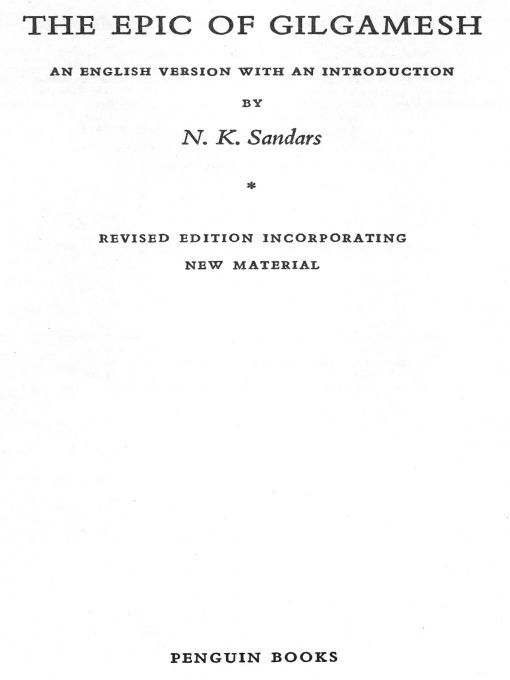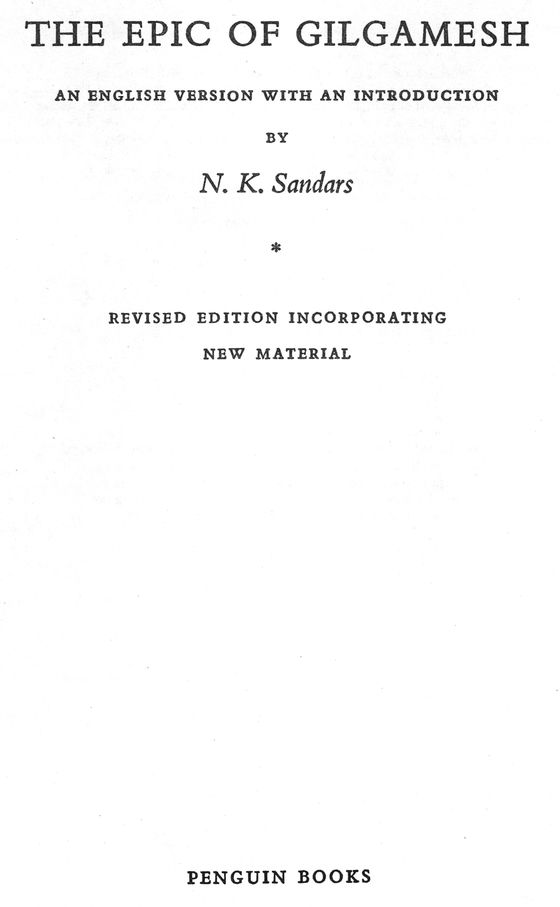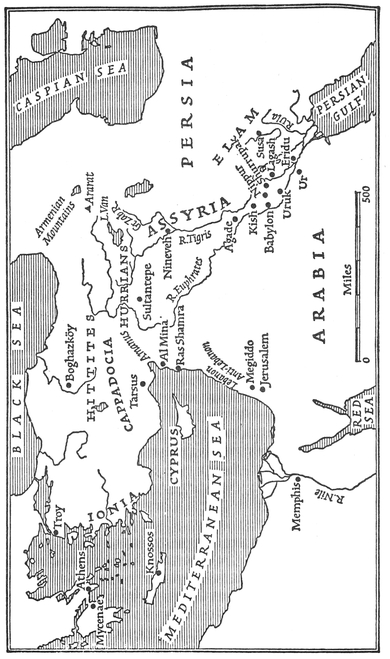The Epic of Gilgamesh
Read The Epic of Gilgamesh Online
Authors: Anonymous


Table of Contents
Â
Â
PENGUIN
 CLASSICS
CLASSICS
 CLASSICS
CLASSICSTHE EPIC OF GILGAMESH
Â
Â
N. K. SANDARS studied, soon after the war, with Professor Gordon Childe at the Institute of Archaeology, University of London, and took the diploma of the Institute. She continued to work at Oxford, taking a B.Litt. degree in the prehistory of Europe, and thereafter she worked on the prehistory of the Aegean, receiving a studentship at St Hugh's College, Oxford, a scholarship from Oxford University and a travelling prize from the University of Liverpool. She has travelled extensively in Europe and in the Near and Middle East, and has taken part in excavations in the British Isles and overseas. She has contributed articles to various journals and is the author of
Bronze Age Cultures in France
(1957),
PrehistoricArtin Europe
(Pelican History of Art, 1968),
Poems of Heaven and HellfromAncient Mesopotamia
(Penguin Classics, 1971) and
The Sea Peoples
(1978). She has written and lectured extensively on the poet and painter David Jones, and on the origins and history of art. N. K. Sandars is a fellow of the British Academy and of the Society of Antiquaries of London and a corresponding member of the German Archaeological Institute. A book of her poems,
Grandmother's
Steps
and
Other
Poems,
was published in 2000 by Poets' and Painters' Press.
Bronze Age Cultures in France
(1957),
PrehistoricArtin Europe
(Pelican History of Art, 1968),
Poems of Heaven and HellfromAncient Mesopotamia
(Penguin Classics, 1971) and
The Sea Peoples
(1978). She has written and lectured extensively on the poet and painter David Jones, and on the origins and history of art. N. K. Sandars is a fellow of the British Academy and of the Society of Antiquaries of London and a corresponding member of the German Archaeological Institute. A book of her poems,
Grandmother's
Steps
and
Other
Poems,
was published in 2000 by Poets' and Painters' Press.

PENGUIN BOOKS
Â
Published by the Penguin Group
Penguin Books Ltd, 80 Strand, London WC2R 0RL, England
Penguin Putnam Inc., 375 Hudson Street, New York. New York 10014, USA
Penguin Books Australia Ltd, 250 Camberwell Road, Camberwell, Victoria 3124, Australia
Penguin Books Canada Ltd, 10 Alcorn Avenue, Toronto, Ontario, Canada M4V 3B2
Penguin Books India (P) Ltd, 11 Community Centre, Panchsheel Park, New Delhiâ110 017, India
Penguin Books (NZ) Ltd, Cnr Rosedale and Airborne Roads, Albany, Auckland, New Zealand
Penguin Books (South Africa) (Pty) Ltd, 24 Sturdee Avenue, Rosebank 2196, South Africa
Penguin Books Ltd, 80 Strand, London WC2R 0RL, England
Penguin Putnam Inc., 375 Hudson Street, New York. New York 10014, USA
Penguin Books Australia Ltd, 250 Camberwell Road, Camberwell, Victoria 3124, Australia
Penguin Books Canada Ltd, 10 Alcorn Avenue, Toronto, Ontario, Canada M4V 3B2
Penguin Books India (P) Ltd, 11 Community Centre, Panchsheel Park, New Delhiâ110 017, India
Penguin Books (NZ) Ltd, Cnr Rosedale and Airborne Roads, Albany, Auckland, New Zealand
Penguin Books (South Africa) (Pty) Ltd, 24 Sturdee Avenue, Rosebank 2196, South Africa
Â
Penguin Books Ltd, Registered Offices: 80 Strand, London WC2R 0RL, England
Â
Â
This translation first published 1960
Reprinted with revisions 1964
Reprinted with revisions 1972
62
Â
Copyright ©N. K. Sandars, 1960, 1964, 1972All rights reserved
Â
Set in Monotype Bembo
Â
Â
eISBN : 978-1-101-16045-9

INTRODUCTION
1. The History of the EpicTHE Epic of Gilgamesh, the renowned king of Uruk in Mesopotamia, comes from an age which had been wholly forgotten, until in the last century archaeologists began uncovering the buried cities of the Middle East. Till then the entire history of the long period which separated Abraham from Noah was contained in two of the most forbiddingly genealogical chapters of the Book of Genesis. From these chapters only two names survived in common parlance, those of the hunter Nimrud and the tower of Babel; but in the cycle of poems which are collected round the character of Gilgamesh we are carried back into the middle of that age.
These poems have a right to a place in the world's literature, not only because they antedate Homeric epic by at least one and a half thousand years, but mainly because of the quality and character of the story that they tell. It is a mixture of pure adventure, of morality, and of tragedy. Through the action we are shown a very human concern with mortality, the search for knowledge, and for an escape from the common lot of man. The gods, who do not die, cannot be tragic. If Gilgamesh is not the first human hero, he is the first tragic hero of whom anything is known. He is at once the most sympathetic to us, and most typical of individual man in his search for life and understanding, and of this search the conclusion must be tragic. It is perhaps surprising that anything so old as a story of the third millennium B.C. should still have power to move, and still attract readers in the twentieth century A.D., and yet it does. The narrative is incomplete and may remain so; nevertheless it is today the finest surviving epic poem from any period until the appearance of Homer's
Iliad:
and it is immeasurably older.
Iliad:
and it is immeasurably older.
We have good evidence that most of the Gilgamesh poems were already written down in the first centuries of the second millennium B.C., and that they probably existed in much the same form many centuries earlier, while the final recension, and most complete edition, comes from the seventh century library of Assurbanipal, antiquary and last great king of the Assyrian Empire. This Assurbanipal was a formidable general, the plunderer of Egypt and Susa; but he was also the collector of a notable library of contemporary historical records, and of much older hymns, poems, and scientific and religious texts. He tells us that he sent out his servants to search the archives of the ancient seats of learning in Babylon, Uruk, and Nippur, and to copy and translate into the contemporary Akkadian Semitic those texts which were in the older Sumerian language of Mesopotamia. Amongst these texts, âWritten down according to the original and collated in the palace of Assurbanipal, King of the World, King of Assyria', was the poem which we call the Epic of Gilgamesh.
Not long after the completion of this task of collation the epic was virtually lost and the hero's name forgotten, or disguised and garbled out of recognition; until it was rediscovered in the last century. This discovery was due, in the first place, to the curiosity of two Englishmen, and thereafter to the labours of scholars in many different parts of the world, who have pieced together, copied, and translated the clay tablets on which the poem is written. It is a work which continues, and more gaps are being filled in each year; but the main body of the Assyrian Epic has not been altered in essentials since the monumental publications of text, transliteration, and commentary by Campbell Thompson in 1928 and 1930. More recently, however, a new stage has been reached and fresh interest aroused by the work of Professor Samuel Kramer of Pennsylvania, whose collection and translation of Sumerian texts have carried the history of the Epic back into the third millennium B.C. It is now possible to combine and compare a far larger and older body of writings than ever before.
2. The Discovery of the TabletsThe discovery of the tablets belongs to the heroic age of excavation in the mid nineteenth century, when, although methods were not always so scrupulous nor aims so strictly scientific as today, the difficulties and even dangers were greater, and results had an impact which profoundly altered the intellectual perspective of the age. In 1839 a young Englishman, Austen Henry Layard, set off with a friend on an overland journey to Ceylon; but in Mesopotamia he was delayed by a reconnaissance of Assyrian mounds. The delay of weeks was lengthened into years, but in time Nineveh and Nimrud were excavated; and it was from these excavations that Layard brought back to the British Museum a great part of the collection of Assyrian sculptures, along with thousands of broken tablets from the palace of Nineveh.
When Layard began excavating at Nineveh he hoped to find inscriptions, but the reality, a buried library and a lost literature, was more than he could have expected. In fact the extent and value of the discovery was not realized till later when the clay tablets with wedge-shaped characters were deciphered. Some, inevitably, were lost; but over twenty-five thousand broken tablets, a huge number, were brought back to the British Museum. The work of decipherment was begun by Henry Rawlinson, at the residency in Baghdad, where he was stationed as political agent. Before going to Baghdad, Rawlinson, then an army officer in the employ of the East India Company, had discovered what was to prove a principal key to the decipherment of cuneiform in the great inscription, the âRecord of Darius', on the rock of Behistun near Kermanshah in Persia, which is written with cuneiform (wedge-shaped) characters in the Old Persian, Elamite, and Babylonian languages. The work begun by Rawlinson in Baghdad was continued in the British Museum when he returned to England in 1855; and soon after his return he started publishing the
Cuneiform Inscriptions of Western Asia.
In 1866 he was joined, as an assistant in the work on the tablets, by George Smith.
Cuneiform Inscriptions of Western Asia.
In 1866 he was joined, as an assistant in the work on the tablets, by George Smith.
Meanwhile Rassam, Layard's collaborator and successor at Nineveh, had excavated in 1853 that part of the library in which were the tablets of the Assyrian collation of the Gilgamesh Epic. A realization of the importance of the discovery did not come till twenty years later, when in December of 1872, at a meeting of the newly founded Society of Biblical Archaeology, George Smith announced that âA short time back I discovered among the Assyrian tablets in the British Museum an account of the flood.' This was the eleventh tablet of the Assyrian recension of the Epic of Gilgamesh. Soon after this first announcement Smith published the
Chaldean Account of the Deluge,
and with it the outline of the Gilgamesh narrative. Interest was immediate and widespread; but the Deluge tablet itself was incomplete, so the search for more tablets was renewed. The
Daily Telegraph
contributed 1,000guineas towards further excavation at Nineveh, which George Smith was to undertake for the British Museum. Quite soon after his arrival at Nineveh, Smith found the missing lines from the description of the flood, which was then, as it still is today, the most complete and best preserved part of the whole Epic. Many more tablets were found in this and the following year, and Smith was able to fill in the broad outline of the Assyrian version before, in 1876, he succumbed to sickness and hunger, and died near Aleppo at the age of thirty-six; but already he had opened up a new field in Biblical studies and in ancient history.
Chaldean Account of the Deluge,
and with it the outline of the Gilgamesh narrative. Interest was immediate and widespread; but the Deluge tablet itself was incomplete, so the search for more tablets was renewed. The
Daily Telegraph
contributed 1,000guineas towards further excavation at Nineveh, which George Smith was to undertake for the British Museum. Quite soon after his arrival at Nineveh, Smith found the missing lines from the description of the flood, which was then, as it still is today, the most complete and best preserved part of the whole Epic. Many more tablets were found in this and the following year, and Smith was able to fill in the broad outline of the Assyrian version before, in 1876, he succumbed to sickness and hunger, and died near Aleppo at the age of thirty-six; but already he had opened up a new field in Biblical studies and in ancient history.
Other books
Without Any Warning (A Samantha Jamison Mystery Volume 2) by Edelheit, Peggy A.
Detective Wade Jackson Mystery - 03 - Thrilled to Death by L. J. Sellers
SNAKE (a Stepbrother Romance) by Beaumont, Emilia
The Marquis Takes a Bride by M.C. Beaton
Whitechapel Gods by S. M. Peters
Night Watchman (The Tubby Dubonnet Series Book 8) by Tony Dunbar
Shrinking Violet by Danielle Joseph
An Inconvenient Desire by Alexia Adams
Hidden Moon by K R Thompson